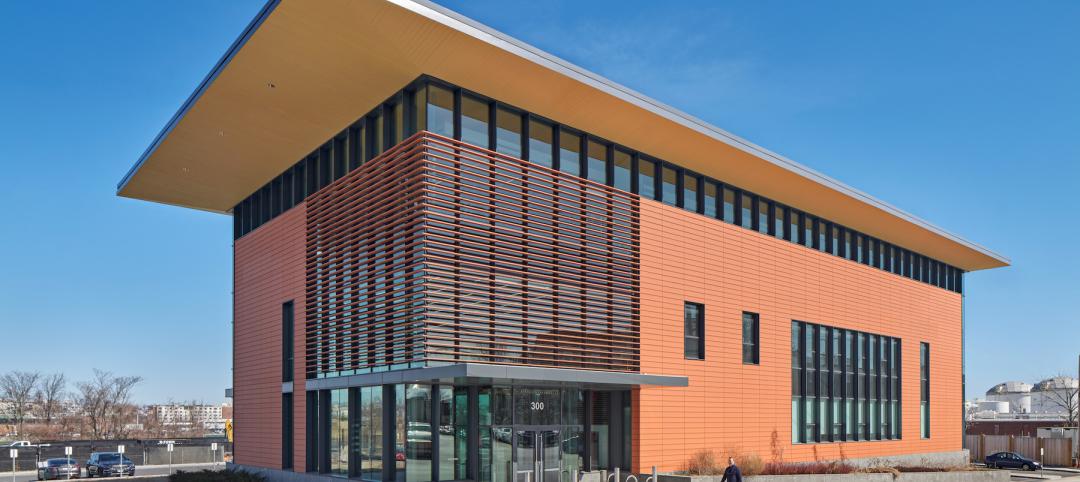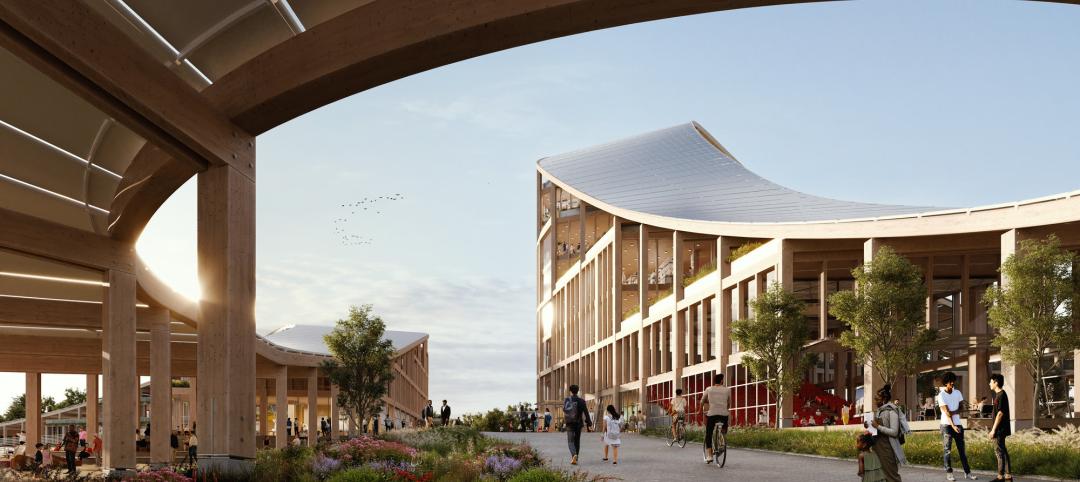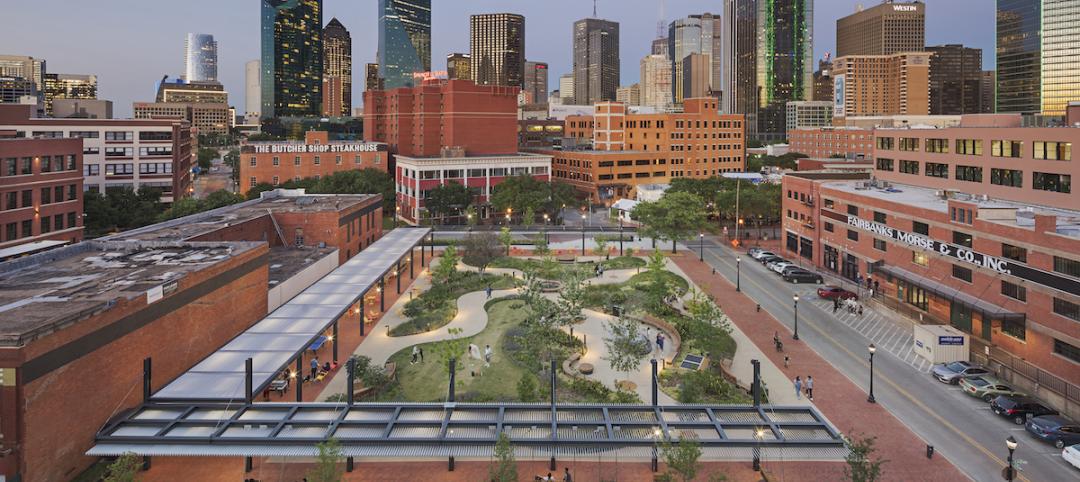At 35 stories, the State Courts Towers at Havelock Square is the tallest government building in Singapore. And while it’s been open since December 2019—when the State Courts started relocating from a nine-story building that dated back to 1975—details and images about its design and construction have only recently been made public by CPG Consultants, the S$450 million (US$334.6 million) project’s Principal Consultant and Architect.
The 178-meter (584-ft) building contains 53 courtrooms and 54 hearing chambers. The structure, designed by Serie + Multiply Consultants, is actually two slender buildings, the Court Tower and Office Tower, connected by 39 link bridges. The design optimizes visibility to the public, with courtroom boxes placed onto large “court trays” of different heights and sizes that are completely open in that there is no glazed façade around the tower.

The towers' 53 courtrooms are placed onto “trays” of different sizes that are “open,” in that there's no glazed facade. Illustration: CPG Consultants
Each “tray” includes a garden terrace that filters sunlight and allows for views of the city. The courtrooms themselves are clad in pigmented precast panels, five to 12 meters in height, whose colors and textures match the tiled roofs of shophouses in Singapore’s nearby Chinatown.
“The relationship between the city and its civic buildings was our primary interest for this project,” explains Christopher Lee, Principal at Serie Architects UK. “The new State Courts Towers should be a building that is symbolically open and accessible to the public. Its design language is drawn from the architecture typical of the city and hence is both familiar and surprisingly new to its citizens.”

The front tower includes the courtrooms and is accessible to the public; the back tower is for judges' chambers and conference rooms. The towers are linked by 39 bridges. lIlustration: CPG Consultants; Image: Khoogj

A SMART, TRANSPARENT BUILDING

The cladding for the courtrooms is precast panels, 5 to 12 ft in height, whose colors and textures match to roofs of nearby shops in Singapore's Chinatown. Image" Finbarr Fallon
The office tower, for judges’ chambers and staff offices, features a vertical façade that expands where light and views are required in the middle, and contracts where the service core is located. Horizontal grids draw the viewer’s eye across the façade and to the sky.
The towers include a coworking space managed by the Singapore Academy of Law, for attorneys and tech companies; a theatrette, business center, cafeteria, roof garden and sky terraces, and a library and auditorium located in the basement.
The complex’s smart building features include facial recognition and automated building management processes for security and MEP systems. Other IT or web-enabled services introduced include video-conferencing facilities and interactive self-service kiosks. A universal design approach was adopted to ensure that it is user-friendly to the judges, persons in custody, and the public, for example in providing Assistive Listening Systems for court attendees and in all its courtrooms, digital wayfinding through apps.
The State Courts Towers is an environmentally sustainable building, with green building features incorporated in its design, such as solar panels and condensate water recovery systems.

Open space, acoustics, user inclusion, visibility, and smart technology were important factors in the design of the courtrooms. Illustration: CPG Consultants; Image: Khoogj

Related Stories
Government Buildings | Jul 13, 2023
The recently opened U.S. Embassy in Ankara reflects U.S. values while honoring Turkish architecture
The U.S. Department of State’s Bureau of Overseas Buildings Operations (OBO) has recently opened the U.S. Embassy in Ankara, Turkey. The design by Ennead Architects aims to balance transparency and openness with security, according to a press statement. The design also seeks both to honor Turkey’s architectural traditions and to meet OBO’s goals of sustainability, resiliency, and stewardship.
Green | Jun 26, 2023
Federal government will spend $30 million on novel green building technologies
The U.S. General Services Administration (GSA), and the U.S. Department of Energy (DOE) will invest $30 million from the Inflation Reduction Act to increase the sustainability of federal buildings by testing novel technologies. The vehicle for that effort, the Green Proving Ground (GPG) program, will invest in American-made technologies to help increase federal electric vehicle supply equipment, protect air quality, reduce climate pollution, and enhance building performance.
Government Buildings | Jun 16, 2023
A police station in Boston attempts to bridge the divide separating law enforcement and the public
An investment in workers and residents, the new building is also more efficient and sustainable.
Engineers | Jun 14, 2023
The high cost of low maintenance
Walter P Moore’s Javier Balma, PhD, PE, SE, and Webb Wright, PE, identify the primary causes of engineering failures, define proactive versus reactive maintenance, recognize the reasons for deferred maintenance, and identify the financial and safety risks related to deferred maintenance.
Government Buildings | May 18, 2023
GSA launches first biennial construction award program
Today, the U.S. General Services Administration (GSA) announced the new biennial GSA Construction Award program, which is seeking submissions this summer. The program was created to honor outstanding achievements in construction, with a focus on quality and craftsmanship, collaboration and team dynamics, sustainability, innovation, and technology. The first Construction Awards ceremony will take place in 2024.
Mass Timber | May 1, 2023
SOM designs mass timber climate solutions center on Governors Island, anchored by Stony Brook University
Governors Island in New York Harbor will be home to a new climate-solutions center called The New York Climate Exchange. Designed by Skidmore, Owings & Merrill (SOM), The Exchange will develop and deploy solutions to the global climate crisis while also acting as a regional hub for the green economy. New York’s Stony Brook University will serve as the center’s anchor institution.
Urban Planning | Apr 12, 2023
Watch: Trends in urban design for 2023, with James Corner Field Operations
Isabel Castilla, a Principal Designer with the landscape architecture firm James Corner Field Operations, discusses recent changes in clients' priorities about urban design, with a focus on her firm's recent projects.
Market Data | Apr 11, 2023
Construction crane count reaches all-time high in Q1 2023
Toronto, Seattle, Los Angeles, and Denver top the list of U.S/Canadian cities with the greatest number of fixed cranes on construction sites, according to Rider Levett Bucknall's RLB Crane Index for North America for Q1 2023.
Contractors | Apr 10, 2023
What makes prefabrication work? Factors every construction project should consider
There are many factors requiring careful consideration when determining whether a project is a good fit for prefabrication. JE Dunn’s Brian Burkett breaks down the most important considerations.
Architects | Apr 6, 2023
New tool from Perkins&Will will make public health data more accessible to designers and architects
Called PRECEDE, the dashboard is an open-source tool developed by Perkins&Will that draws on federal data to identify and assess community health priorities within the U.S. by location. The firm was recently awarded a $30,000 ASID Foundation Grant to enhance the tool.
















